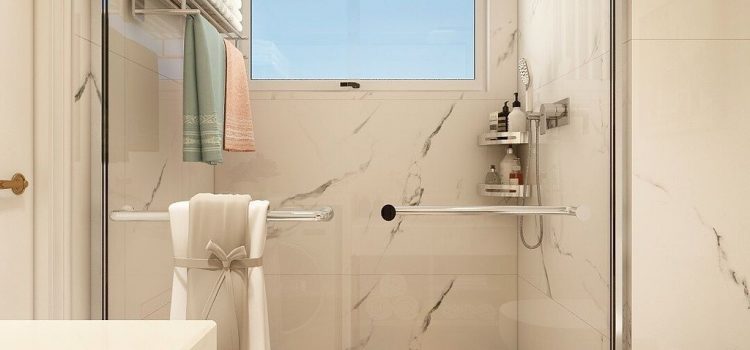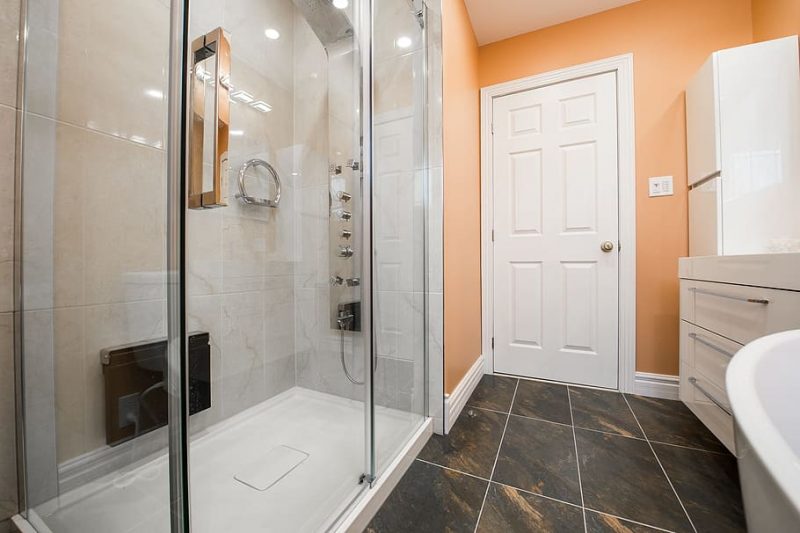
How to Choose a Walk-in Shower Tray
A walk-in shower tray is easy to install on the floor. It comes in various shapes, materials, and sizes to suit your taste and your bathroom or shower configuration.
Note: you can also choose a recessed shower tray if you want it to disappear into the floor.
Why choose a walk-in shower tray?
Features
The walk-in tray is the easiest to install. It is installed either on the floor or on a base, made of polystyrene to be tiled, bricks, or cinder block. Unlike the flush-mounted shower tray, it does not require significant work since only the drain and the outlet, if they are not already planned, need digging up the floor.
What about an extra-flat shower tray
However, some people criticize the height of the shower tray, which means that you have to climb over it to get into the shower. There are, therefore, extra-flat trays. Measuring only 4 to 5 cm, they allow you to create a walk-in shower, just like an Italian shower, but without the constraints of construction. Since the space under the tray is reduced, the drainage system will be either vertical or hidden in a base on which the tray will rest.
Choosing a shower tray

Shapes and dimensions
Depending on the size you want to give your shower and any layout constraints, you can choose from many shapes and sizes (including custom-made ones) of shower trays.
The most classic shower tray is square. This choice is often preferred in bathrooms with small dimensions, especially since the tray can even fit in a corner. You’ll find it in 70 × 70 cm, 80 × 80 cm, 90 × 90 cm, and 100 × 100 cm for maximum comfort.
For smaller bathrooms, the quarter-round shower tray is the space-saving solution par excellence. It, too, can be fitted into a corner. Its standard dimensions: 80 × 80 cm, 90 × 90 cm and 100 × 100 cm.
In a long bathroom, a rectangular shower tray is preferred. Its standard dimensions are 72 × 90 cm, 75 × 100 cm, 80 × 120 cm and 90 × 120 cm.
Finally, in a narrow bathroom, you may direct the choice to a pentagonal tray. Its standard dimensions: 90 × 90 cm.
Materials to compare
You will choose the material of your shower tray according to its aesthetics, of course, and its qualities, maintenance, and cost. Another criterion that may influence your choice is the bearing capacity of the floor. If your bathroom floor requires light sanitaryware, you should opt for acrylic, one of the three most common shower tray materials. At the same time, ceramic or natural stone, which is particularly heavy, should be avoided.
Most common shower tray materials
The most standard shower tray is made of ceramic (or glazed stoneware). Its advantages are numerous: attractive cost, resistance, durability, and ease of maintenance. It must have an anti-slip treatment to prevent any risk of falling.
The shower tray is made of acrylic and has a smooth surface. Although its lightness is an asset, it is more expensive than a ceramic model and easily scratched. However, it allows XXL dimensions.
The free-standing shower tray made of synthetic resin combines strength, durability, and stability. It is famous for its aesthetics, especially since it can imitate other materials such as wood, concrete, slate, leather, etc. But the price still climbs, and some can be sensitive to chemicals.
More original shower tray materials
When made of solid surface, a material composed of minerals, pigments, and acrylic or polyester resin, the shower tray is resistant, insulating, self-supporting, repairable, and non-slip but very expensive.
If made of synthetic concrete, the shower tray offers a modern look, is resistant and durable, but is also expensive.
It can also be made of enameled steel; it is scratch-resistant and easy to maintain but also very strong.
Made of wood, it offers an incomparable aesthetic. It is to be chosen in naturally rot-proof species. Rare because it requires significant expertise, it is costly and must be carefully maintained.
Natural stone is aesthetic and noble but heavy and requires careful maintenance. The alternative is to choose a reconstituted stone shower tray made of natural elements crushed and compacted by a binder like concrete or cement before being dyed and molded to give them the appearance of natural stone. It is less expensive and does not need to be treated.
Prices and where to buy
You can find a free-standing shower tray in DIY stores, specialist shops, and on the Internet. The price depends on the material, the size, and of course, the manufacturer.
Count on $60 to more than $1,000 for a wooden model, for example.
Read more:
Pipes and Wrenches | Installing a Shower Tray
Creating a Walk-in Shower With a Ready-to-Tile Shower Tray
What can I use instead of a shower tray?



